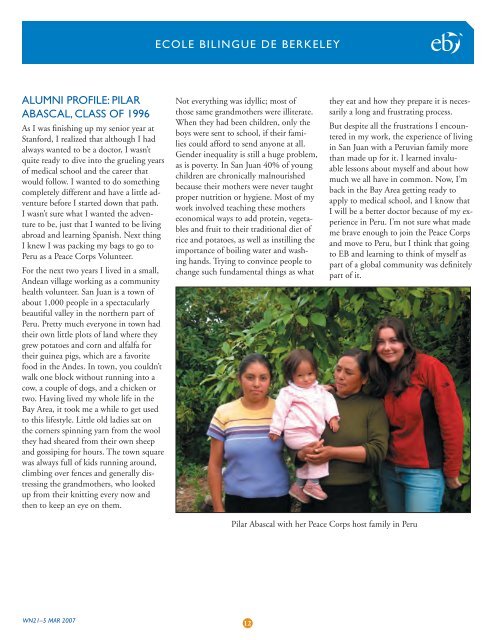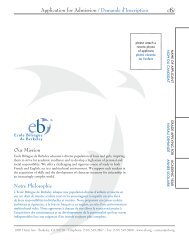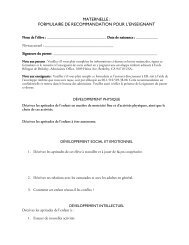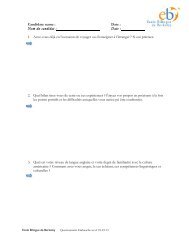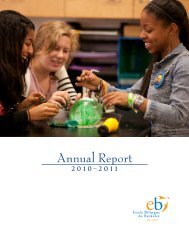Alumni Profiles - Ecole Bilingue de Berkeley
Alumni Profiles - Ecole Bilingue de Berkeley
Alumni Profiles - Ecole Bilingue de Berkeley
Create successful ePaper yourself
Turn your PDF publications into a flip-book with our unique Google optimized e-Paper software.
ECOLE BILINGUE DE BERKELEY<br />
ALUMNI PROFILE: PILAR<br />
ABASCAL, CLASS OF 1996<br />
As I was finishing up my senior year at<br />
Stanford, I realized that although I had<br />
always wanted to be a doctor, I wasn’t<br />
quite ready to dive into the grueling years<br />
of medical school and the career that<br />
would follow. I wanted to do something<br />
completely different and have a little adventure<br />
before I started down that path.<br />
I wasn’t sure what I wanted the adventure<br />
to be, just that I wanted to be living<br />
abroad and learning Spanish. Next thing<br />
I knew I was packing my bags to go to<br />
Peru as a Peace Corps Volunteer.<br />
For the next two years I lived in a small,<br />
An<strong>de</strong>an village working as a community<br />
health volunteer. San Juan is a town of<br />
about 1,000 people in a spectacularly<br />
beautiful valley in the northern part of<br />
Peru. Pretty much everyone in town had<br />
their own little plots of land where they<br />
grew potatoes and corn and alfalfa for<br />
their guinea pigs, which are a favorite<br />
food in the An<strong>de</strong>s. In town, you couldn’t<br />
walk one block without running into a<br />
cow, a couple of dogs, and a chicken or<br />
two. Having lived my whole life in the<br />
Bay Area, it took me a while to get used<br />
to this lifestyle. Little old ladies sat on<br />
the corners spinning yarn from the wool<br />
they had sheared from their own sheep<br />
and gossiping for hours. The town square<br />
was always full of kids running around,<br />
climbing over fences and generally distressing<br />
the grandmothers, who looked<br />
up from their knitting every now and<br />
then to keep an eye on them.<br />
Not everything was idyllic; most of<br />
those same grandmothers were illiterate.<br />
When they had been children, only the<br />
boys were sent to school, if their families<br />
could afford to send anyone at all.<br />
Gen<strong>de</strong>r inequality is still a huge problem,<br />
as is poverty. In San Juan 40% of young<br />
children are chronically malnourished<br />
because their mothers were never taught<br />
proper nutrition or hygiene. Most of my<br />
work involved teaching these mothers<br />
economical ways to add protein, vegetables<br />
and fruit to their traditional diet of<br />
rice and potatoes, as well as instilling the<br />
importance of boiling water and washing<br />
hands. Trying to convince people to<br />
change such fundamental things as what<br />
they eat and how they prepare it is necessarily<br />
a long and frustrating process.<br />
But <strong>de</strong>spite all the frustrations I encountered<br />
in my work, the experience of living<br />
in San Juan with a Peruvian family more<br />
than ma<strong>de</strong> up for it. I learned invaluable<br />
lessons about myself and about how<br />
much we all have in common. Now, I’m<br />
back in the Bay Area getting ready to<br />
apply to medical school, and I know that<br />
I will be a better doctor because of my experience<br />
in Peru. I’m not sure what ma<strong>de</strong><br />
me brave enough to join the Peace Corps<br />
and move to Peru, but I think that going<br />
to EB and learning to think of myself as<br />
part of a global community was <strong>de</strong>finitely<br />
part of it.<br />
Pilar Abascal with her Peace Corps host family in Peru<br />
WN21–5 MAR 2007<br />
12


